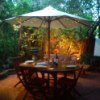Tours in Argentina
Topic: Camino Real and Cultural Tours
Cultural Tours in Argentina.
Bob Frassinetti, Art and Antique Dealer from Argentina caters for people from around the globe with an interest in the Argentinean Spanish language, culture, art and society. We operate in conjunction with highly trained academic staff of respected institutions and specially selected local artists and crafts people play a central teaching role for this program unlike other learning experiences is unique as well as customise to fit your needs. The main part of the learning activity takes place in workshops with patient and friendly teachers and in lovely and comfortable environments. Groups are limited to 10 participants so that our teachers can give you an unusual degree of individual attention. To intensify your experience of Argentinean "Portenian" ( that of the inhabitants of Bs As ) culture, as much as that of the Interior of the Country we participate in a number of traditional activities and we take you off the tourist trail, behind the scenes, without ever compromising your safety or comfort. Our groups stay in small, cosy hotels and lodges whose local character and unpretentious charm bring you closer to the people and their traditional way of life. Finally, we offer you all of this at a very competitive price
See also our information on, Press Links below Travel Argentina , Lighthouse around Argentina Tour and Route 40 Tour, Camino Real, Camino del Inca, ...........
For more information you can also email me.
Email Bob Frassinetti. admin@frassinetti.com
Bob Frassinetti. Copyright 2005 2018 Roberto Dario Frassinetti.
Private dinners
Northern Cordoba, along the Old Royal Road, known in Spanish as Camino Real. Beginnings The route originated as the "Camino Real del Perú" (Royal Road of Peru), used since colonial times to travel from Buenos Aires, through Córdoba, Santiago del Estero, San Miguel de Tucumán, Salta, San Salvador de Jujuy, and Potosí, continuing to Perú. The section between Buenos Aires and the south of what it is today Cordoba Province, was shared with the "Camino Real del Oeste" (Royal Road of the West) which branched towards San Luis, Mendoza and Santiago (Chile). The road had a system of small inns and establishments every 50 km where travellers could rest. After the coming of the railroad, in the second half of the 19th Century, this road lost relevance, as the railroad provided faster service on any type of weather. The first train from Buenos Aires arrived in the town of La Quiaca in Argentina's northern border with Bolivia on 30 December, 1907.[1] With the advent of the automobile, the Federal Government decided to build roads throughout the Republic. In 1936 the road from Buenos Aires to La Quiaca was named Ruta Nacional 9 (National Route 9). In 1943 the road was open to traffic in its full length, even though most of it was unpaved. The road started competing against the railroad, taking passengers and cargo. The last passenger train to La Quiaca arrived on December 1993, and the last cargo train in July 1994.[1] So if you are interested in Art or Antiques, and you are travelling to Buenos Aires, or to other parts of Argentina, like Rosario, Entre Rios, Cordoba or Mendoza, please feel free to email me, I travel all Argentina, Chile, Paraguay, Uruguay, Route 40 Argentina, Ruta 40 Argentina, Buenos Aires, San Telmo, Flea Markets, Travel Adventure, Travel guide mentioned in Lonely Planet, as well as Lighthouses Tours or the fantastic Provincial Route 14, Tras la Sierra in Cordoba, as well as Villa Tuluma, the Villa in the Valley of Tulumba along the Royal Road, I can help, from Guided Tours to Exporting Antiques and Art …….
Camino Real, Camino del Inca and Cultural Tours
Bob Frassinetti on Face Book
Noticias del Camino Real
Villa Tulumba Camino Real Cordoba Argentina
San Francisco del ChaCamino Real
Bob Frassinetti Biz Up Dates
Bob Frassinetti Export Antiques
Bob Frassinetti on Face Book
Noticias del Camino Real
Villa Tulumba Camino Real Cordoba Argentina
San Francisco del ChaCamino Real
Bob Frassinetti Biz Up Dates
Bob Frassinetti Export Antiques



